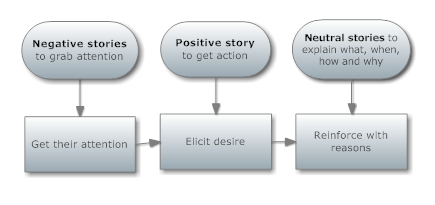 Your blog writing can improve. What if there were a secret formula you could use to grab people’s attention, stimulate their desire, and trigger action? Ba-da-boom, instant sales and subscriptions.
Your blog writing can improve. What if there were a secret formula you could use to grab people’s attention, stimulate their desire, and trigger action? Ba-da-boom, instant sales and subscriptions.
Don’t be silly, there are no easy formulas, of course not. But just follow along with me here. I’ve been reading several neuroscience and communications books that say the same things in different ways, and I think these persuasion tips can easily apply to better blog writing.
Take a look at this diagram I whipped up with SmartDraw:
 Grabbing readers’ attention is the first step, of course. (By the way, this doesn’t only apply to blog writing, but to other content marketing pieces and in general for web pages.)
Grabbing readers’ attention is the first step, of course. (By the way, this doesn’t only apply to blog writing, but to other content marketing pieces and in general for web pages.)
Attention is generally done more effectively by negative content. That’s because negative stories wake us up. They activate the more primitive centers of the brain, especially the centers for fight or flight.
Negative stories start us thinking. For example, a reader might jolt up in their chair and think, “Oh dear, this could happen to me…” Like watching a car accident, we’re drawn into a story that is full of danger or fear.
But negative stories generate worry and anxiety, as well as caution. (You may be one of those cool dudes with an Alfred E. Neuman attitude, but don’t worry, even cool dudes feel the fear subconsciously. Oh yes you do, you just don’t admit it…)
Here’s the secret key to getting readers to act: negative stories get our attention, but they don’t stimulate us to action. To get readers to act, they have to want something different. So to stimulate a desire for change, you must switch your writing to positive stories.
In this part of your blog post, you start describing a better future. You enable the reader to see possibilities they have missed. Once their negativity buttons are triggered, you’ve got their attention, now do something with that.
When your blog writing includes positive stories, for example, how a client’s life changed when they started using your product, readers start seeing themselves in the picture.
Readers can see themselves in your story, and begin to imagine doing something new and different. This is how you stimulate desire for change. It is how you get readers primed to take the next step, to take the action you are going to suggest to them.
Let me tell you a personal story. Read More→









Blog Content: Are you personal… or all business?
I got an interesting comment on a post I did beginning of June and I can’t stop thinking about it. The post was about staying on target with your business goals when you create content for your blog. Don’t Jerk Readers Around: 5 Tips for Staying on Track.
First Eileen said she didn’t agree with my premise that you might be jerking readers around if you’re not staying on track with your content:
“I’m not sure I agree with this. My blog niche is arts and crafts. Most of my favorite other artsy blogs do this routinely. One day they blog about what happening at home. The next they may share a tutorial or run a contest or review a book.”
Then Keenan said, “I agree with Eileen. Although you don’t want to be completely all over the map, changing up your subject matter is critical.
“Blogs represent people. They create connections to their readers through their personalities. When a blog stays on topic all the time, it begins to feel white-washed like any on or off-line newspaper or magazine.
“Personality plays a huge role in a blog. Blogging about those things that are part of the authors passions, likes, dislikes, opinions etc. allows followers to connect with the blog. It’s what makes blogging different than reading commercial news. Read More→